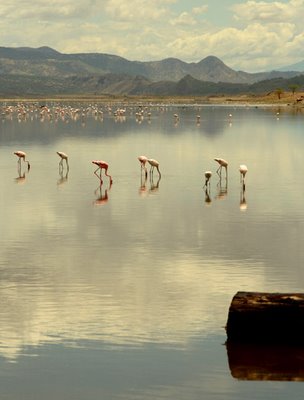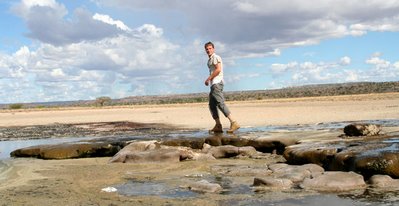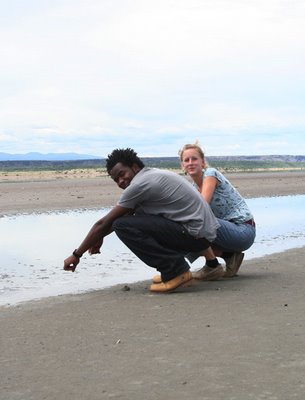The green outskirts of Nairobi, where I live whenever I am in town, make it easy to forget about the hot, semi arid landscape that is spreading out beyond the southern boarders of the city. One hour drive, and the luscios green has changed into a kaleidoskop of beige, brown, and and yellow. Another hour drive, and one can reach to lake Magadi, in the centre of what is known as massai land. The lake doesn't have any outlet, so the salts flowing in from the nearby springs are trapped and concentrated by evaporation. As a result, the surface of the lake is glittering in all kind of colours, from green to pink.
The Massais, the indiginous inhabitants of this part of Kenia, have named the lake after the Soda that comes from it's waters. Today, the entire area around the lake is owned by the Lake Magadi Soda Company, which built houses, a swimmingpool, a golfcourse and some restaurants where the youngsters of the village can idle during weekends. Its only fair to keep the inhabitants - who to a great extent work for the company - happy; after all, the lake is the worlds second largest producer of sodium carbonate. This is however hard to believe, when looking at the town and surrounding areas: The trail that leads to the fabric looks old and rusty, the fabric seems like a smoking ghost in the middle of nowhere, and the Magadi village has somehow the (symphatetic) flair of a deserted township taken out of a wild west film. Nothing much that reminds of a busy industrial town.
The colorful surface of the lake is shared by Flamingos who dont mind the sodium cloride. It seems that out of the four milllion flamingos that are inhabitating the area of the great rift valley, at least 1 million must be living around lake Magadi.
The conclusion after a trip to this forgotten place is that it is defenitely not a typical tourist area (we met one other car during the entire day), but worth a trip for those who feel attracted by empty and rough landscapes.

Flamingos  more flamingos
more flamingos
 And for a change, hot springs (and Ib)
And for a change, hot springs (and Ib) Katharina and Jeff
Katharina and Jeff
